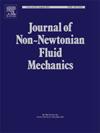Flow enhancement produced by a pulsatile flow of shear-thinning fluids in circular and concentric annular tubes
IF 2.8
2区 工程技术
Q2 MECHANICS
引用次数: 0
Abstract
Although the analysis of the flow enhancement of non-Newtonian fluids produced by pulsatile flows through tubes is common in the literature, the case of Carreau fluid has not been analyzed, which is the aim of this work. This study determines the flow enhancement caused by the pulsatile fluid flow through (a) a circular tube and (b) a concentric annular tube. We show that the flow rate enhancement of the shear-thinning fluid is controlled by the Carreau number , the Womersley number , the fluid power-law index , the ratio between the outer and inner radii , a parameter that represents the ratio between the infinite and zero-shear viscosities, and the amplitude of the oscillatory signal . In both cases (a) and (b), a numerical solution of the start-up of the hydrodynamic is evaluated. With the aid of the velocity solution, the volumetric flow rate is determined under periodic conditions after the initial transient has vanished. Then, the fractional increase in the mean flow rate due to the pulsatile pressure gradient is calculated. Furthermore, an asymptotic solution for small, intermediate, and very large values of the Carreau number is performed to provide physical insight into flow enhancement.
剪切稀化流体在圆形和同心环形管中的脉动流动所产生的流动增强效应
虽然分析非牛顿流体脉动流过管子时产生的流动增强在文献中很常见,但尚未对卡略流体的情况进行分析,而这正是本研究的目的所在。本研究确定了脉动流体流经 (a) 圆管和 (b) 同心环形管时产生的流量增强。我们发现,剪切稀化流体的流速增强受卡略数 Cu、沃默斯利数 Wo、流体幂律指数 n、内外半径之比 κ、表示无限剪切粘度和零剪切粘度之比的参数 β 以及振荡信号振幅 ɛ 的控制。在(a)和(b)两种情况下,都对流体动力的启动进行了数值求解。借助速度解法,可以确定初始瞬态消失后周期条件下的容积流量。然后,计算出脉动压力梯度导致的平均流速 I 的部分增长。此外,还对卡略数的小值、中间值和极大值进行了渐近求解,以提供对流动增强的物理洞察。
本文章由计算机程序翻译,如有差异,请以英文原文为准。
求助全文
约1分钟内获得全文
求助全文
来源期刊
CiteScore
5.00
自引率
19.40%
发文量
109
审稿时长
61 days
期刊介绍:
The Journal of Non-Newtonian Fluid Mechanics publishes research on flowing soft matter systems. Submissions in all areas of flowing complex fluids are welcomed, including polymer melts and solutions, suspensions, colloids, surfactant solutions, biological fluids, gels, liquid crystals and granular materials. Flow problems relevant to microfluidics, lab-on-a-chip, nanofluidics, biological flows, geophysical flows, industrial processes and other applications are of interest.
Subjects considered suitable for the journal include the following (not necessarily in order of importance):
Theoretical, computational and experimental studies of naturally or technologically relevant flow problems where the non-Newtonian nature of the fluid is important in determining the character of the flow. We seek in particular studies that lend mechanistic insight into flow behavior in complex fluids or highlight flow phenomena unique to complex fluids. Examples include
Instabilities, unsteady and turbulent or chaotic flow characteristics in non-Newtonian fluids,
Multiphase flows involving complex fluids,
Problems involving transport phenomena such as heat and mass transfer and mixing, to the extent that the non-Newtonian flow behavior is central to the transport phenomena,
Novel flow situations that suggest the need for further theoretical study,
Practical situations of flow that are in need of systematic theoretical and experimental research. Such issues and developments commonly arise, for example, in the polymer processing, petroleum, pharmaceutical, biomedical and consumer product industries.

 求助内容:
求助内容: 应助结果提醒方式:
应助结果提醒方式:


